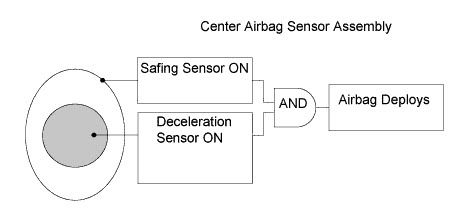Góp vui với mấy bác về vị trí airbag sensor - Tây lói:
http://www.villagetoyotaparts.com/showAssembly.aspx?ukey_assembly=320137
Hilux SRS Airbag system (April 2005 on)
The vehicle is equipped with a Supplemental Restraint System (SRS), which consists of a steering pad, front passenger airbag, seat belt pretensioner, center airbag sensor and front airbag sensor.
The location of these items is shown in Figure 1 and Figure 2, Below:
The schematic for the SRS components shown above are outlined in Figure 3 below:
Operation in case of front collision
When an impact that is larger than a predetermined level occurs in the highlighted area in Figure 4. the airbag is deployed automatically.
The center airbag sensor deceleration sensor uses the front airbag sensor's deceleration sensor signal to determine whether or not to activate the airbag.
The center airbag sensor safing sensor is designed to activate at a deceleration rate that is lower than that of the center airbag sensor deceleration sensor. When the safing sensor and deceleration sensor turn on simultaneously, current flows to the squib and the airbag deploys. This is shown graphically in the diagram below.
When the vehicle is in a collision and the shock is greater than the specified value, the SRS is activated automatically. The safing sensor and deceleration sensor are built into the center airbag sensor. The safing sensor is designed to be turned on at a smaller deceleration rate than the deceleration sensor. The deceleration sensor determines whether or not SRS deployment is necessary based on signals from the front airbag sensor. Current flows to the squibs to deploy the SRS when the conditions shown in the illustration in Figure 6 below are met.
Affect of a body lift on the SRS
General Discussion
It can be seen from the technical description above that all of the SRS components and the wiring shown schematically in figure 3 are located on the passenger body shell. There are no SRS components or wiring attached to the vehicle chassis.
Therefore, there is no affect on the SRS system if the body shell is raised in relation to the chassis.
The only possible consideration could be that the point of impact of a collision being higher where a body lift of up to 50mm is considered. However, it is noted that raising the point of impact by the same amount can just as easily be achieved by a 50mm suspension lift that fully complies with the suspension travel requirements of VSR 8. The point of impact in a frontal collision can also be affected if the vehicle is airborne at the time of impact. This is quite probable where a vehicle leaves a built up roadway and collides with a stationery object within the shaded areas of Figure 4. Under these conditions, if deployment conditions are met, the SRS airbags will deploy regardless of whether a body lift is installed in the vehicle or not.
 . Chuyện tai nạn này thì các báo mạng đăng ầm hết cả rồi , cả nước ai cũng biết . Mình cứ chờ doanh số tháng sau của con altis này ra sao rồi bàn tiếp cũng còn vui chán . Các bác có đồng í với em khg nào
. Chuyện tai nạn này thì các báo mạng đăng ầm hết cả rồi , cả nước ai cũng biết . Mình cứ chờ doanh số tháng sau của con altis này ra sao rồi bàn tiếp cũng còn vui chán . Các bác có đồng í với em khg nào 
 . Chuyện tai nạn này thì các báo mạng đăng ầm hết cả rồi , cả nước ai cũng biết . Mình cứ chờ doanh số tháng sau của con altis này ra sao rồi bàn tiếp cũng còn vui chán . Các bác có đồng í với em khg nào
. Chuyện tai nạn này thì các báo mạng đăng ầm hết cả rồi , cả nước ai cũng biết . Mình cứ chờ doanh số tháng sau của con altis này ra sao rồi bàn tiếp cũng còn vui chán . Các bác có đồng í với em khg nào 



 hoặc chưa đến mức túi khí phải bung.
hoặc chưa đến mức túi khí phải bung.





